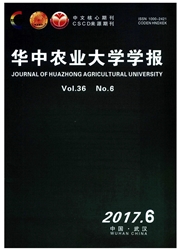

 中文摘要:
中文摘要:
以陕西安塞自然植被土壤和农田土壤(包括施有机肥、施无机肥、不施肥对照)为研究对象,通过分析各粒级团粒中有机质和碳酸钙的分布特征及去除胶结物质前后的粒度组成,探讨不同农业利用条件对黄土团聚特征的影响。结果表明:不同利用方式下的土壤均以粒径〉0.05 mm(45%-65%)和粒径0.002-0.05 mm(30%-45%)的团粒为主;相对于自然土壤,农业活动对粗粒级团粒中碳酸钙的溶解再沉淀过程具有促进作用,增加粒径〈0.002mm次生碳酸钙含量;不施肥和施用无机肥显著降低粒径〈0.002 mm团粒的有机质含量,而施用有机肥显著增加粒径〉0.05mm和粒径〈0.002mm团粒的有机质含量,有利于大团聚体(250-1 000μm)的形成;逐步去除胶结物质过程中,不同利用方式的土壤团粒逐渐破碎,粒度分布曲线和累计曲线均向左不同程度推移。不同利用方式的土壤中碳酸钙和有机质均对土壤颗粒产生胶结作用,且施用有机肥的土壤中碳酸盐和有机质的胶结团聚作用最强。
 英文摘要:
英文摘要:
The contents of organic matter and calcium carbonate in different size aggregation and the particle size distribution of Los-Orthic Entisols in Ansai (Shaanxi) Province under different uses with and without binding agents removal were analyzed. The effects of agricultural utilization on loess ag- glomerate characteristics were investigated. The results showed that aggregate in soils under different uses were dominated by 〉0.05 mm (45%-65%) and 0.002-0.05 mm (30%-45%) aggregate. Agronomic activities promoted the leaching and deposition of calcium carbonate resulting in a great enhancement of secondary carbonate in 〈0.002 mm fraction compared with the natural soil. No fertilization treatment (CK) and inorganic fertilizer application (NK) significantly reduced organic matter content in〈0.002 mm fraction. But organic fertilizer treatment significantly increased organic matter content in 〉0.05 mm and 〈0.002 mm fraction and subsequently favored the formation of macroaggregate of 250-1 000 μm. Gradual removal of binding agents caused the shift of soil particle size distribution curve and cumulative curve to the left with varying degrees as a result of aggregate fragmentation. It is indicated that both calcium carbonate and organic matter cementation occurred in the soils under different land uses. The ce- mentation of calcium carbonate and organic matter was strongest in soil with organic fertilizer applica- tion. It will provide scientific basis for improving soil quality and productivity in loess region.
 同期刊论文项目
同期刊论文项目
 同项目期刊论文
同项目期刊论文
 期刊信息
期刊信息
